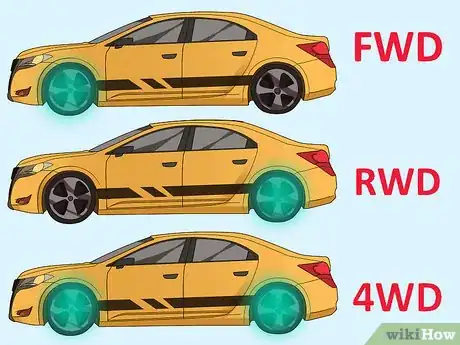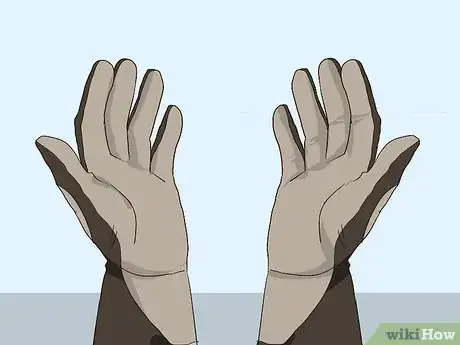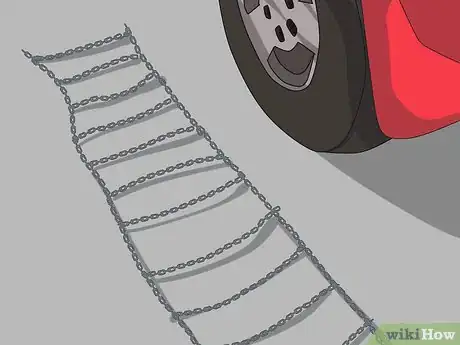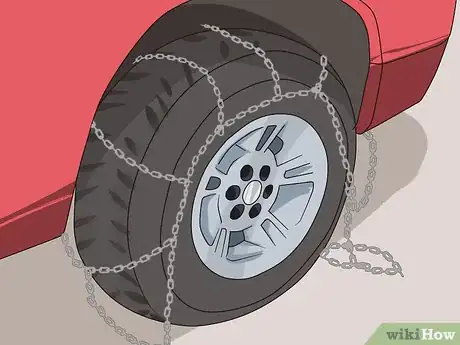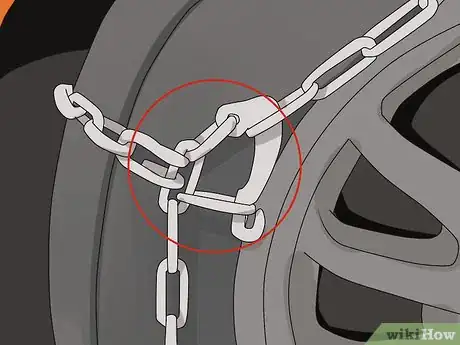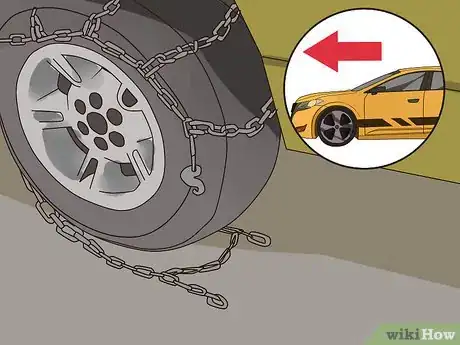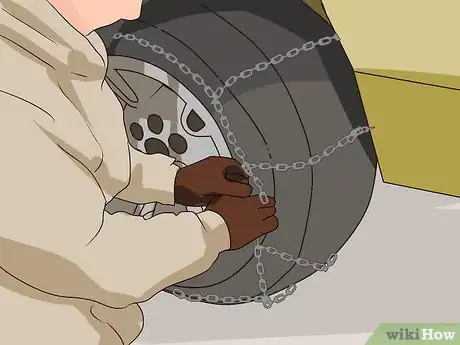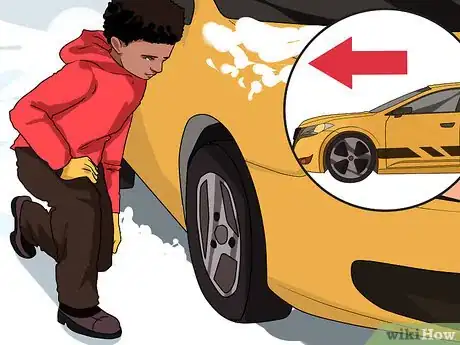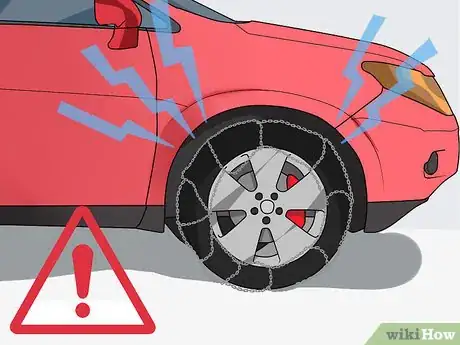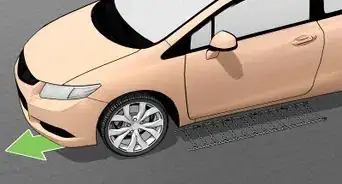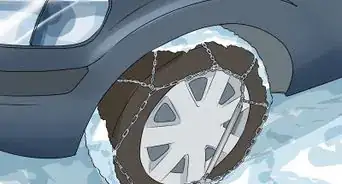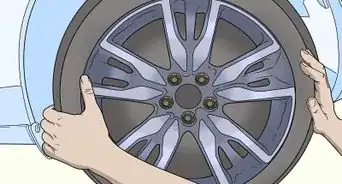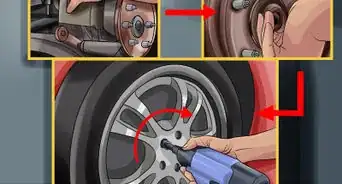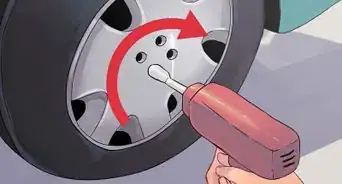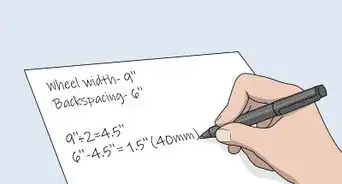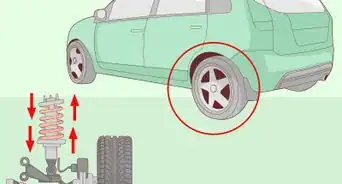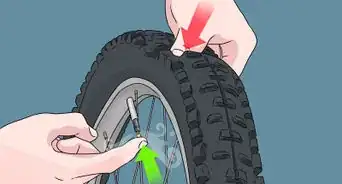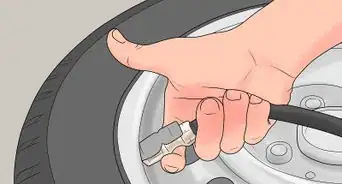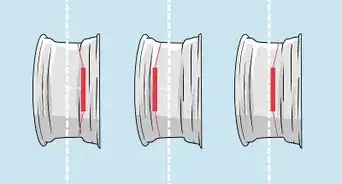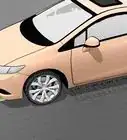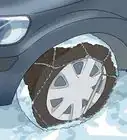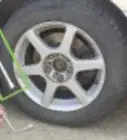This article was co-authored by wikiHow Staff. Our trained team of editors and researchers validate articles for accuracy and comprehensiveness. wikiHow's Content Management Team carefully monitors the work from our editorial staff to ensure that each article is backed by trusted research and meets our high quality standards.
This article has been viewed 53,503 times.
Learn more...
You may need snow chains (also called tire chains) for extra traction in mountainous areas, or even in lowland areas that get a lot of snow. Make it a point to practice installing snow chains before you actually need them. This ensures that you'll know what to do, even when installing them in adverse conditions. It’s important to remember that snow chains may help you gain traction in the snow, but they will not help you stop on icy roads, so be extremely careful when driving in snowy or icy conditions.
Steps
Preparing to Install Snow Chains
-
1Identify the drive wheels of the vehicle. Snow chains are intended to help you gain traction in the wheels that push the vehicle. Depending on the application, that may be the front wheels, the rear wheels, or all four. Refer to your vehicle’s owner’s manual if you are unsure which wheels are the drive wheels.[1]
- Front wheel drive cars (FWD) will use snow chains on the front wheels.
- Rear wheel drive cars (RWD) will use them on the rear.
- All wheel drive (AWD) or four-wheel drive (4WD) will need them on all four wheels.
-
2Purchase the right snow chains for your tire size. The chain packaging will state which tires it fits, but don't be afraid to ask for advice at your local auto parts store. It is more important that you find chains intended to fit on the size tire you have, rather than for your specific vehicle, as aftermarket wheels or tires may change the size required. [2]
- Never attempt to use chains that are too large or too small, as this could result in dangerous driving and damage to your car.
- If you are unsure of what size tires you have, you can find the sizes printed on the sidewall of each of them.
Advertisement -
3Select a safe location to install the chains. Most people find themselves in need of using snow chains while they are already on the road. Hazardous driving conditions that require snow chains in conjunction with snow banks on the sides of the road can make stopping to mount your chains dangerous, so look for a safe, open space with enough room for you to work without being in the road. [3]
- A wide stretch of road with a broad shoulder or a parking lot will allow for proper chain placement while keeping you safe.
- Never install your snow chains in the road, as other vehicles may not be able to stop before hitting you.
-
4Wear insulated gloves. Installing snow chains will require that you put your hands into the wheel wells of your vehicle, which will likely be heavily caked with ice, slush and snow. In order to protect your hands and fingers from frost bite, put on a pair of insulated gloves before you begin installing the snow chains. [4]
- Waterproof gloves are preferable, as they will likely become wet as you work.
Installing Snow Chains
-
1Untangle the chains and lay them near the drive tires. For front wheel drive vehicles lay both sets of chains by the 2 front tires. For rear-wheel drive vehicles, place them near the rear tires. Untangle the chains and lay them out in a ‘web’ shape. If you have a 4WD vehicle you must apply snow chains to all 4 tires to retain full control. [5]
- You may need to remove your gloves to untangle the chains if they are extremely tangled.
-
2Pull one chain over the first wheel. Drape the chain over the first tire. It should fit snug despite the lower part of the tire not be attached yet. If necessary, knock any snow buildup in the wheel well out so you can access both sides of the tire. [6]
- Be sure the chain is draped over the width of the tire, and not simply on the outside that is easiest to access.
-
3Connect the chain keepers if yours came with them. Some snow chain sets come with rings called keepers that help secure the chain in place on your tire. Connect the keepers to your rim by following the instructions that came with the chains.
- Different chain sets that have keepers may utilize different methods of securing them.
- The keepers will help ensure the chains don’t fall off as you move the vehicle forward to complete the installation.
-
4Repeat the process on the other drive wheel or wheels. Once you have the first wheel draped with the chains, do the same to the other side of the vehicle. If your vehicle is equipped with four wheel drive, you will need to repeat the process for all four wheels before moving on to the next step. [7]
- By placing all of the chains before moving the vehicle, you will reduce the number of times you have to pull the vehicle forward in order to attach all of the chains.
- You should never drive a vehicle with only one chain installed.
-
5Pull the vehicle forward a few feet. With the chains on each drive wheel, pull the vehicle forward to expose the bottom portion of the wheels and tires that you have not yet been able to secure the chains to.
- Ask a friend to tell you when to stop once you have rotated the wheels so the unchained bottom is now facing up.
- The distance you will need to move forward will vary depending on the size of your wheels and tires.
-
6Secure the remaining part of the chain. Once you have moved the vehicle forward far enough to access the unchained portion of the tires, secure the chains to the bare area in the same fashion you secured them to the rest of the wheel. Make sure to connect the keepers to this area as well if your chains came equipped with them. [8]
- Make sure to repeat the process on each drive wheel.
- The chains should now be secure and snug on the wheels and tires.
Driving with Snow Chains
-
1Drive a short distance and check the chains. Get into the vehicle and drive it down the road slowly for a few hundred yards. Then get out and inspect the snow chains for any slack as they have started to find their placement in the grooves of the tires. Tighten the chains where needed with a closer link provided with the snow chains kit.
- If the chains are loose, they will not function properly.
- Follow the directions in the chain kit for the installation of the closer link, as different brands have different application methods.
-
2Listen for signs the chains are too loose. The ride in your vehicle will be louder than normal due to the chains, but if you hear a sound coming directly from one of the vehicle’s wheel wells, it may be indicative of a chain that’s come loose. Stop the vehicle and inspect the chains any time you hear something unusual from the wheel wells.[9]
- Loose or damaged chains can whip around, damaging the body of your vehicle.
-
3Practice driving slowly. Give yourself an opportunity to get accustomed to driving with snow chains by starting off very slowly. The vehicle’s driving dynamic will be different due to the chains on the wheels and the difficult driving conditions, so it may take some getting used to. [10]
- Take it slow until you begin to feel comfortable with how the vehicle handles with snow chains in place.
-
4Maintain low speeds. Driving at speeds in excess of 25 miles per hour with snow chains on is not recommended and can be unsafe. The chains may wear quickly or even come apart at high speeds, which can cause damage to your vehicle or cause you to lose control.
- Remember that chains help propel you, but cannot help you stop on icy surfaces.
- Always maintain a safe speed for the environment, particularly in hazardous and snowy conditions.
References
- ↑ http://www.tirerack.com/winter/tech/techpage.jsp?techid=128
- ↑ http://www.dmv.org/how-to-guides/tire-chains.php
- ↑ http://www.dmv.org/how-to-guides/tire-chains.php
- ↑ http://www.dmv.org/how-to-guides/tire-chains.php
- ↑ http://www.tirerack.com/winter/tech/techpage.jsp?techid=128
- ↑ http://www.chamonix.net/english/chamonix/how-to-fit-snow-chains-to-your-tires
- ↑ http://www.chamonix.net/english/chamonix/how-to-fit-snow-chains-to-your-tires
- ↑ http://www.chamonix.net/english/chamonix/how-to-fit-snow-chains-to-your-tires
- ↑ http://www.dmv.org/how-to-guides/tire-chains.php
